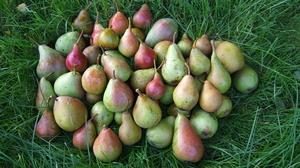Grant Scheme Activities
Phase X
| Fifth Call (2021) |
Phase IX
| Fourth Call (2016) | |
| First Call (2014) |
Working Group activities and related events
February 2025
Within the EVA Boost project, relevant stakeholders from the fruit tree and berries sectors will meet in Ancona do discuss a framework to establish a new EVA network on perennial plants, involving members from the ECPGR Berries, Malus/Pyrus and Prunus Working Groups. [More info]
May 2023
The final report of the Pomefruit C&E Activity is available online [here]
November 2022
The ECPGR Characterization and Evaluation Descriptors for Apple Genetic Resources are available online [here]
May 2022
The ECPGR Characterization and Evaluation Descriptors for Pear Genetic Resources are available online [here]
January 2021
Partners of the Pomefruit C&E Activity published the following article: Genetic diversity of pear germplasm in Bosnia and Herzegovina, as revealed by SSR markers (946,0 KB)
May 2018
The Pomefruit C&E Progress Report for 2017 is now available [here].
April 2017
The Pomefruit C&E project meeting was held 26-27 April 2017 in Gembloux, Belgium. [more info]
December 2016
The project on "Common ECPGR protocols and tools available for Characterization & Evaluation of Malus/Pyrus genetic resources (Pomefruit C&E)", submitted by the Malus/Pyrus Working Group for funding under the Fourth Call of the ECPGR Activity Grant Scheme, was selected by the Executive Committee. [more info]
December 2014
The project on “Building and promoting a European Pyrus collection – A case study (ECoHisPy - European Collection of Historical Pyrus)", submitted by the Malus/Pyrus Working Group for funding under the ECPGR Activity Grant Scheme, was selected by the Executive Committee. [more info]
March 2012
An ad hoc meeting on fruit synonyms was held on 5 March 2012 in Weggis, Switzerland followed by a meeting on descriptors (6 March) and by the fourth meeting of the ECPGR Malus/Pyrus Working Group, 6-9 March 2012 [link to ECPGR archive]
Working Group operative documents
- Working Group Chair’s report for Phase IX (prepared for the Fifteenth ECPGR Steering Committee Meeting) (see here)
Background information
During an ECPGR ad hoc workshop on Malus germplasm, held in June 1995 at Wye College, University of London, UK, European country delegates expressed concern that genetic uniformity prevailing in commercial apple production was a threat to the apple industry in Europe. The ability of commercial European production to survive future external fluctuations was thought to be dependent on the availability of a broad genetic base.
In order to harmonize and rationalize the European collections of Malus and Pyrus, and therefore optimize European capital and labour resource utilization, a number of recommendations were made, including the proposal to establish an ECPGR Working Group on Malus/Pyrus with the following tasks:
- Definition of a minimum set of standardized characterization descriptors
- Characterization of all European Malus and Pyrus collections
- Inclusion of characterization data into a central European database for Malus and for Pyrus
- Definition of additional standardized evaluation descriptors
- Definition of standard methodologies for evaluation
- Development and implementation of a comprehensive European Malus and Pyrus conservation strategy, taking in consideration:
- A classification system of what is unique, rare, at risk, etc.
- National requirements, for example, UPOV responsibilities
- Ensurance of evolutionary adaptation to local conditions to continue provision of new variations of diversity - Development of a European strategy for collecting germplasm, in particular from regions within Europe where unevaluated wild Malus and Pyrus populations are known to exist
- Consideration of multilateral agreements for access to and exchange of germplasm.
The ECPGR Steering Committee formalized the establishment of a Working Group on Malus/Pyrus in September 1995 and the Group met for the first time in Dublin, Ireland in May 1997.
Related Information
Other Working Group documents and publications of interest
Useful links
- Crop Trust - Conservation strategies
- ECPGR Central Crop Databases - Fruit
- Genebank Standards for Plant Genetic Resources for Food and Agriculture (FAO, 2014)
- FAO-AGP Seeds and Plant Genetic Resources Web site
- European Fruit Research Institutes Network
- Fruit Genetic Resources of Estonian University of Life Sciences
